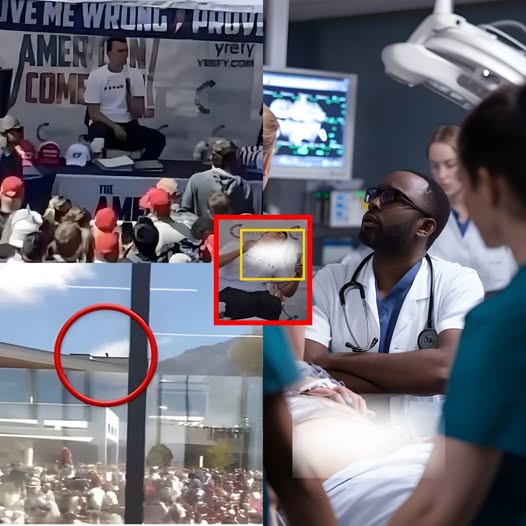“What really happened to Charlie Kirk?” — Doctors were left stunned after reviewing the footage frame by frame. He appeared to lose control in just 0.4 seconds, and that hand movement wasn’t what anyone thought. Something seen in the unreleased frame — cut at the exact moment — could change everything.
For weeks, the question has refused to fade:
What really happened to Charlie Kirk in those final seconds caught on camera — and why was part of the footage never shown to the public?
The video in question, lasting barely twelve seconds, has now become one of the most analyzed clips on the internet. Thousands of viewers have slowed it down, replayed it, and argued endlessly about one particular moment —
the subtle movement of Charlie’s hand before the frame abruptly cuts out.
At first glance, it looked like nothing more than a natural gesture. But according to specialists who’ve examined the footage in detail, something very different may have occurred.
And now, with new insights from medical professionals, video analysts, and even people who were in the room that day, the story is shifting in a way no one saw coming.

The Moment That Sparked a Thousand Theories
It began as an ordinary recording. Charlie Kirk was mid-sentence, responding to a question, when his right hand moved slightly toward his chest. In the next instant — less than half a second later — the frame flickered, and the broadcast cut to a different angle.
Nothing seemed unusual at first. But when the clip resurfaced online, viewers noticed something strange about the movement. It didn’t look like a conscious gesture — it looked involuntary.
That’s when the theories exploded.
Online forums, podcasts, and TikTok breakdowns began to appear overnight. Some users claimed Charlie had signaled something. Others believed it was simply a glitch. But one theory quickly gained traction:
that the movement was a reflex — the kind that occurs when the body suddenly loses control.

Frame-by-Frame: What Experts Found
Neurologists and motion experts were brought in to study the footage frame by frame — and what they discovered shocked even them.
In their detailed analysis, they found that Charlie appeared to lose muscular control in just 0.4 seconds.
That’s less than half a blink.
Dr. Andrew Laskin, a neurophysiologist from Boston, explained:
“When we slow the footage to microsecond intervals, we see that the movement of the fingers does not match normal voluntary motion. It’s abrupt, then still — the kind of interruption we associate with a brief loss of consciousness.”
The revelation set off a wave of debate. If that was true, what had caused it? And why did the footage cut away at the exact moment the reaction occurred?
The Missing Frame
In high-resolution broadcasts, video frames are captured at 30 per second. That means that between two visible images, a camera captures data that’s sometimes compressed or removed when footage is processed.
But several video editors who analyzed the clip claim that one specific frame — the one following Charlie’s hand motion — appears to be missing entirely.
That single frame, they argue, could have shown what truly happened in that instant.
Digital forensics consultant Maya Chen reviewed multiple versions of the footage and noticed something unusual:
“There’s an inconsistency between the live feed and the archived copy. It’s a one-frame skip — about 1/30th of a second — but it happens exactly when the motion peaks. That’s rare for a broadcast file.”
To most viewers, 1/30th of a second means nothing. But to those looking for answers, that missing fragment has become the key to understanding the mystery.

A Sudden Loss of Control
If the experts are correct, what caused Charlie to lose control so suddenly?
Doctors who’ve studied the clip have proposed several possibilities — all medical, none conspiratorial.
One theory involves a brief neurological event: a momentary lapse caused by stress, exhaustion, or even dehydration. Others suggest it could be a fainting reflex, the kind triggered when blood pressure drops unexpectedly.
But what truly caught attention was how quickly it happened.
Dr. Laskin noted:
“The human brain can shut down certain motor responses almost instantly when under extreme strain. It’s rare, but possible. That 0.4-second window is just enough time for involuntary movement before stillness sets in.”
Still, what confuses many is the immediate cut in the broadcast feed — a coincidence that has only deepened public curiosity.
Why Was the Scene Cut?
Producers who handled the broadcast insist that the cut was standard — a transition between camera angles triggered automatically by the studio system.
Yet, critics aren’t satisfied.
The timing of that switch, aligning perfectly with the unexpected hand motion, feels too convenient to some viewers.
One anonymous technician familiar with the system explained:
“Camera switching is automated, but it reacts to timing cues. If something was slightly off, the algorithm might cut earlier than planned. It’s not proof of anything — just a quirk of timing.”
Even so, online sleuths continue to argue that the cut removed a crucial moment — maybe even an explanation.
Social Media Goes Into Overdrive
Within hours of the clip resurfacing, hashtags like #CharlieKirkFrame and #0Point4Seconds began trending on X (formerly Twitter). YouTube creators uploaded slowed-down versions, some zooming in to microscopic levels to analyze every muscle twitch.
Comments flooded in:
“Look at his fingers — that’s not voluntary.”
“He looks like he’s trying to say something.”
“The screen cuts right when it gets weird — that can’t be random.”
What started as a small corner of internet curiosity quickly turned into a viral storm. Even mainstream commentators began referencing “the missing frame” as if it were a historical artifact.
The Internet Detectives
Online researchers — some professional, most amateur — have been tirelessly trying to piece together the event.
One Reddit user compiled a timeline of every available recording from multiple angles, comparing timestamps down to the millisecond. Another claimed to have located raw satellite feed data that showed the same split-second distortion.
None of it conclusively proved anything. But each new “find” added fuel to the story.
As one viewer commented:
“It’s not about what we see — it’s about what we don’t.”
The Human Side of the Story
Amid all the theories and debates, it’s easy to forget there are real people at the heart of this story.
Friends of Charlie have urged restraint, reminding the public that sometimes simple explanations are overlooked in the hunt for intrigue.
One longtime colleague told reporters:
“He was under a lot of pressure. The studio environment, the travel schedule — it takes a toll. People should be focusing on his health and well-being, not treating him like a mystery file.”
Still, even those closest to him admit that the hand motion — and the timing of the cut — are hard to ignore.
A Pattern or a Coincidence?
This isn’t the first time a high-profile broadcast has sparked confusion over missing frames or unexplained edits. In several past cases, automatic camera systems triggered cuts that later fueled conspiracy theories — though all were later proven to be technical mishaps.
Could this be another such case?
Experts suggest yes — but audiences are less convinced. The emotional impact of seeing something strange on live video tends to override logic. Once a mystery catches fire online, it rarely fades quietly.
Doctors Step In Again
After widespread speculation, a group of neurologists offered to provide a clinical perspective. Using enhanced video analysis tools, they reconstructed the sequence and ran simulations to understand what might have caused the rapid motion.
Their conclusion was cautious:
“We observed what appears to be a momentary lapse in motor coordination — possibly stress-induced. It lasted less than half a second. No indication of distress beyond that frame.”
However, they emphasized one thing: without full context, any interpretation remains speculative.
That didn’t stop online discussions — it only shifted them.
Now, instead of asking what happened, people are asking why it looked so unnatural.
“He Looked Aware — Then Suddenly Still”
One particular breakdown from an independent analyst went viral after pointing out micro-expressions on Charlie’s face. In two consecutive frames, his expression changes almost imperceptibly — a shift that appears to occur before the hand motion.
The analyst described it as “the brain flickering between awareness and stillness.”
While most neurologists caution against reading too much into body language, the analysis struck a chord. The public found it unsettling — not because it offered proof of anything, but because it raised an unanswerable question:
What if we all saw something real, but didn’t recognize it at the time?
The Producers Speak Out
Facing mounting speculation, one of the studio producers released a statement.
“The footage was edited for broadcast clarity. There was no removal of content for any other reason. We understand the public’s concern, but there was nothing hidden or altered beyond standard production practice.”
Still, that reassurance didn’t stop the theories. The internet, after all, thrives on unanswered questions.
And this one — with its strange timing, scientific intrigue, and missing frame — had all the ingredients of a modern mystery.
The 0.4-Second Phenomenon
As debates continue, the number “0.4” has taken on symbolic meaning online — representing how quickly things can change, how a single frame can alter perception, and how stories evolve in the age of digital magnification.
Even memes have emerged.
Some show clocks frozen at 0.4 seconds, others feature captions like “It only takes a frame to rewrite the truth.”
Ironically, what started as a technical curiosity has turned into a philosophical reflection on how much of reality we miss when we blink.
A Mystery of Perception
Psychologists have weighed in, suggesting that the fascination with the clip reveals more about us than about the footage itself.
Dr. Karen Feld, a media psychologist, explained:
“When the brain encounters a gap — like a missing frame — it fills in the blanks using imagination. That’s why these stories become so powerful. They turn uncertainty into narrative.”
In other words, the mystery might be less about what actually happened — and more about what we believe we saw.
Where Things Stand Now
Weeks later, the footage remains a subject of fascination. Dozens of videos, think pieces, and breakdowns continue to circulate, each claiming to find something new.
Yet, despite all the attention, one truth remains: no one outside the production team has seen the complete unedited recording.
And until that changes, speculation will continue — fueled by the idea that one missing frame could hold the answer.
Final Thoughts
In an era where every second is analyzed, dissected, and replayed, the mystery surrounding Charlie Kirk’s 0.4-second moment reminds us how fragile truth can be in the digital age.
It only takes a fraction of a second — a blink, a flicker, a skipped frame — to turn a simple video into a phenomenon that captures millions.
Perhaps, in the end, the real story isn’t what’s hidden in that frame…
but how deeply we all need to believe there’s something there.
